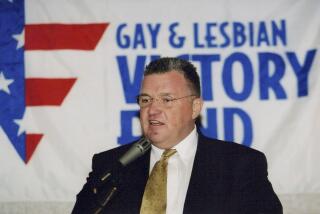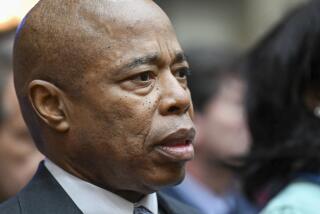Hugh Carey dies at 92; former New York governor
Former New York Gov. Hugh Carey, who led the rescue effort that brought New York City back from the brink of bankruptcy during its 1975 fiscal crisis, has died. He was 92.
Carey died Sunday at his summer home on New York’s Shelter Island, according to Gov. Andrew Cuomo.
Carey, a Democrat, served two terms as governor from 1975 to 1982 after seven terms as a congressman from Brooklyn. Hailed for his crisis management during the city’s brush with insolvency, Carey mustered the backing needed to reorganize its shaky finances and restore confidence in the city and the state.
He also campaigned successfully for merit selection of top state judges, and the well-known “I Love New York” campaign started during his years in office.
Carey took office in January 1975, and the first year was his most challenging and finest.
New York City’s finances were in such a mess in early 1975 that banks refused to lend it more money. Default loomed, but Carey enlisted labor leaders, politicians and fiscal experts and came up with a rescue plan that included strict oversight of all spending by the nation’s largest city.
Shuttling among Albany, New York City and Washington, he won federal loan guarantees from the reluctant Republican administration of President Gerald Ford that secured the plan. Ford’s reluctance made front-page news, immortalized in the New York Daily News headline: “Ford To City: Drop Dead.” Though Ford did not explicitly mouth those words, they were implied in a speech he made initially denying the city federal assistance.
As governor, Carey pushed for job programs and increases in welfare and unemployment benefits, and he started a major tax cut program in 1977.
A staunch Roman Catholic, Carey personally opposed abortion but nonetheless led the fight for Medicaid funding so poor women wouldn’t be denied access to abortions. Years later, he voiced regret over that role.
He opposed capital punishment and six times vetoed bills restoring the death penalty.
“I would like to be remembered as somebody who cared a great deal about people,” Carey said.
But he was also regarded as something of a loner who had difficulty maintaining relationships with subordinates and legislators.
In 1981, an electrical fire contaminated the 18-story Binghamton State Office Building with soot laden with toxic PCBs and dioxin. Carey sought to allay public fears. Describing the situation as “overblown,” he declared: “I offer here and now to walk into Binghamton, to any part of that building and swallow an entire glass of PCBs.”
The remark provoked a storm of derision, and Carey later apologized. The accident is considered the country’s first indoor environmental disaster; the building remained closed for more than 13 years, and the cleanup cost more than the original structure.
His second term bogged down in disputes with the Legislature.
“What am I supposed to do, save New York City twice?” Carey once commented. He declined to seek a third term. He became a partner in a Park Avenue law firm and later a Washington lobbyist.
Before he became governor, Carey spent 14 years in Congress representing his Brooklyn district.
Hugh Leo Carey was born in Brooklyn in 1919. After military service in World War II, he went to law school and then joined the family business; his father was a petroleum distributor. In his first run for Congress, in 1960, he wrested a seat from a four-term Republican incumbent.
Carey and his first wife, Helen, had 14 children. She died in 1974. His 1981 marriage to Chicago millionaire Evangeline Gouletas ended in divorce.
More to Read
Start your day right
Sign up for Essential California for the L.A. Times biggest news, features and recommendations in your inbox six days a week.
You may occasionally receive promotional content from the Los Angeles Times.




















































